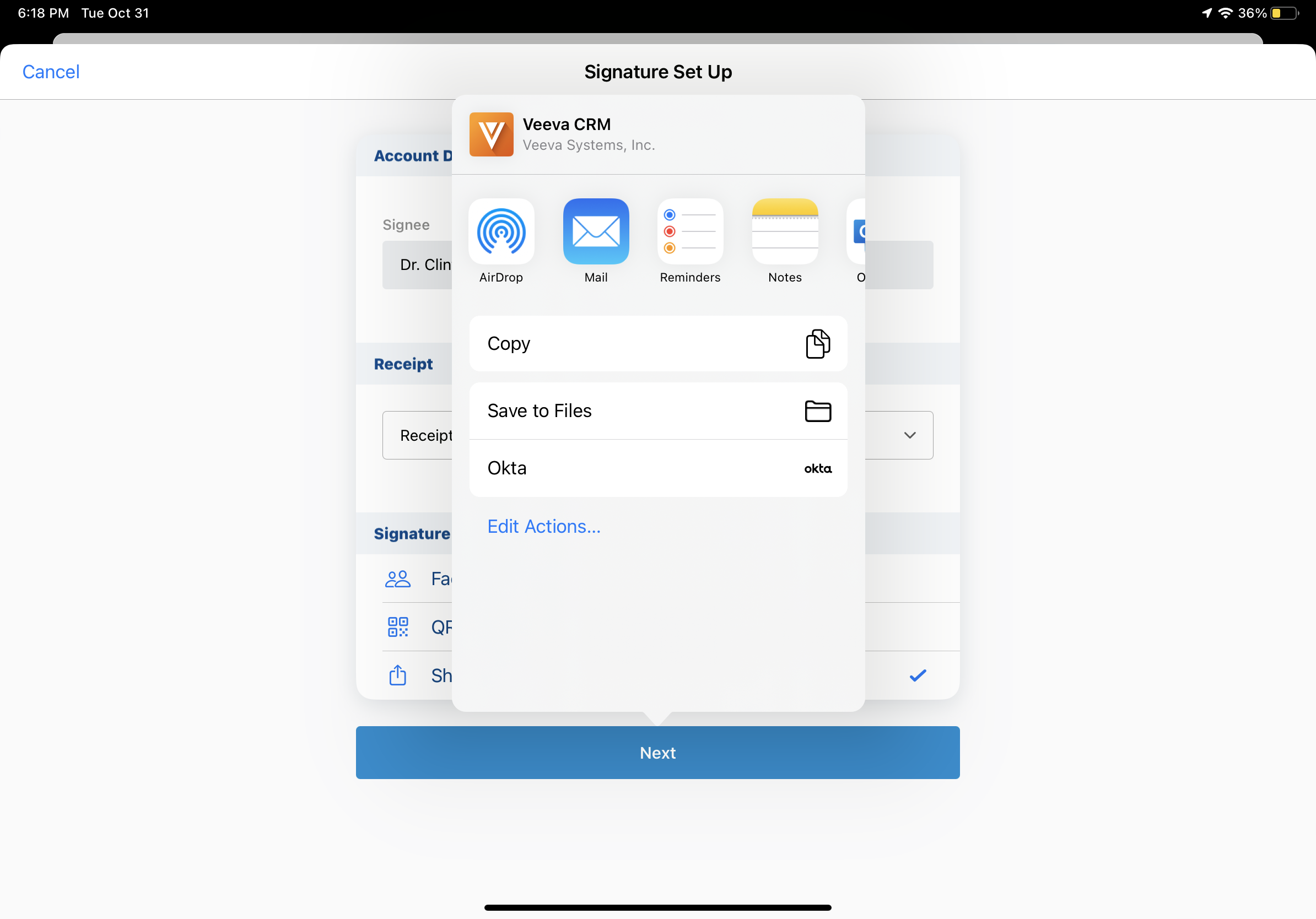20R3.1 Functionality Guide
The Functionality Guide is intended for Sales Operations, Business Administrators, System Integrators, and others responsible for making decisions about what features are needed for end users to be successful and deciding which features work together with existing customer configurations.
Information includes an overview of each feature, examples, screen shots, and targeted information on how to use each feature. Select the heading link to display the topic which includes configuration instructions, if applicable.
Engage
Capturing Remote Signatures for Sampling Using Share Link
- iPad
End users can remotely capture signatures for BRC sampling outside of an Engage meeting. This is useful if the user is meeting with an account remotely, for example, over Zoom or Microsoft Teams, but still wants to disburse BRCs.
For example, Sarah Jones meets with Dr. Clinton Ackerman using his preferred method of virtual communication. Dr. Ackerman requests a BRC sample of Cholecap. Sarah uses the Share Link signature method to send a link to Dr. Ackerman via iMessage. When Dr. Ackerman selects the link on his device, he is guided through a process on his device’s web browser and signs for the BRC.
Considerations
- Share Links are a signature method selected from the Signature Setup Page
- Only BRC-type products can be signed for
- Remote signature capture is supported for person account calls, both with and without the --paa section signal, as well as unique activity child calls. It is not supported for standard group calls.
- A user can only request one remote signature at a time. Requesting signatures from multiple browser tabs, devices, or platforms at the same time is not supported.
- The link is valid as long as the Requesting screen displays in CRM
- Links are only valid for one signature
- Links can only be opened in one browser tab at a time and become invalid as soon as the HCP submits their signature
- The following features are not supported for Browser users capturing remote signatures:
- Approved Email Receipts for Signature Transactions
- Creating Sample and Product Limits
- Supporting State Distributor License Validation
- Sampling with Mid-level Practitioners
- The following browsers are not supported when signing:
- Internet Explorer
- UC Browser
- Desktop WeChat on Windows
Prerequisites
Using Remote Signature Capture for Sampling
To generate and share a link for an attendee to use to sign for BRCs using an iPad:
- Use the Signature Setup page to select Share Link for the Signature Method.
- Select Next.
-
Select the appropriate application to share the generated link with the attendee. After selecting the appropriate option, the end user must remain in Veeva CRM until the attendee provides their signature.
Links display as text in iMessage if the user is not added to the attendee’s contact list.
If an acceptable application is not available, select Copy to copy the link to the device’s clipboard. Users must paste the link into the appropriate application, send the link to the HCP, and return to the Veeva CRM app while the HCP provides a signature. If users do not promptly return to the Veeva CRM app, a notification reminds them to return to the app.

Providing a Remote Signature
When an attendee is requested to sign for a BRC remotely, they receive the link via the application selected by the end user.
Selecting the link displays the internet browser, where the signer can review requested BRCs, sign, and submit their signature via their browser.


Reviewing Remote Signatures
After the HCP signs for the BRC, the end user can review the signature and either accept the signature or request the signer to sign again. If Displaying HCP Information on the Signature Page is enabled, the HCP’s display name is shown on the signature page. When users capture an HCP signature, the value in the Signature_Page_Display_Name_vod field for that account is stamped on the Call2_vod, Sample_Order_Transaction_vod, and Sample_Order_Transaction_Audit_vod records.
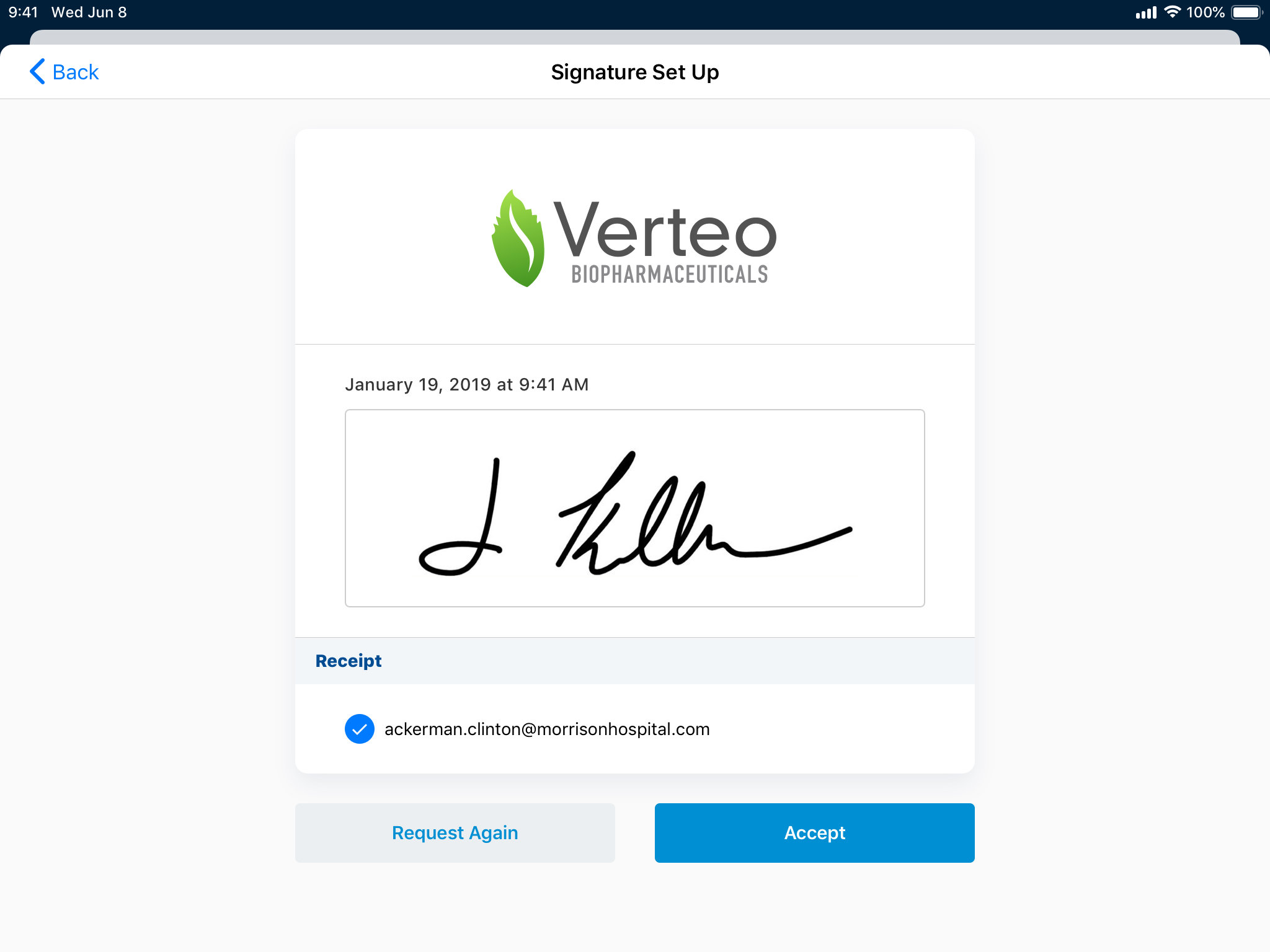
After accepting the signature, the call displays. For auditing purposes, calls where a BRC was signed for remotely automatically have the Signature_Captured_Share_Link_vod check box selected. Any resulting Sample_Order_Transaction_vod and Signature_Order_Transaction_Audit_vod records made from the call also have this check box selected.
Admins can run reports on the Call2_vod, Sample_Order_Transaction_vod, and Sample_Order_Transaction_Audit_vod objects to review a list of all calls and sample order transaction/audit records where a signature was captured remotely. The appropriate Sample Order Transaction and Audit fields are automatically stamped by triggers when users create call records, to preserve data integrity and provide an audit trail.
Events Management
Hosting a Virtual Event using Engage
- iPad
- Browser (Classic)
Event organizers can host virtual events using Engage. This enables event organizers to plan and schedule virtual events just as they would in-person events, enabling attendees to join the meeting using HCP Attendee apps.
For example, Sarah Jones schedules a virtual event with Dr. Ackerman as a speaker. Dr. Adams and Dr. Antonucci are attendees. Sarah designates the event as an Event Meeting and starts the event using Engage. Dr. Ackerman, Dr. Adams, and Dr. Antonucci all join the meeting using HCP Attendee apps.
Considerations
- Virtual event users are added as Engage user groups
- Attendees can join using any of the supported HCP apps, as well as the web client
- This feature is supported in Lightning for Events Management
- Virtual events are not supported on CRM Desktop (Mac)
Prerequisites
- Events Management
- Engage – Configure event organizers as meeting hosts
- Sending Engage Invitations via Approved Email
- Engage Attendance Tracking
Scheduling Virtual Events
To designate an event as a virtual meeting, navigate to the appropriate event and select the Schedule_Engage_vod button. This button displays for selection when the following requirements are met:
- The current user is a licensed Engage user
- The event’s Assigned_Host_vod field is blank
- The event’s Webinar_Status_vod field is Off_vod, Failed_vod or blank

After selecting Schedule Engage, participant URLs are generated for all existing Event Speakers and Event Attendees. Additionally, Webinar_Status_vod field updates to On_vod and creates a corresponding Remote_Meeting_vod record with a record type of Event_vod.
Inviting Attendees and Speakers to Virtual Events
Using the Engage Invitations via Approved Email feature, event organizers can select the Send button to send an Approved Email template to attendees and speakers.
To use an Approved Email Template:
- Ensure the Using Approved Email for Events Management feature is enabled.
-
Grant all users the following additional permissions:
Object
OLS
Record Types
Fields
FLS
Approved_Document_vod
RU
Remote_Meeting_vod
n/a
n/a
Sent_Email_vod
RU
Remote_Meeting_vod
Related_Transaction_ID_vod
Edit
Creating Speaker and Attendee Specific Templates
Approved Email templates sent as invitations to a virtual event can be made specific to either speakers or attendees, enabling greater flexibility when designing templates.
Email templates must have a type of Event Management Invite Template in Vault.
-
Set the Audience field to Speaker or Attendee. If this is left blank, the template is available for all audience types.
Templates sent to attendees should include the
{{EM_Attendee_vod__c.Webinar_Participant_URL_vod__c}}token. Templates sent to speakers should include the{{EM_Event_Speaker_vod__c.Webinar_Panelist_URL_vod__c}}token. Click tracking is not supported for Approved Emails containing URL tokens. - Align the Approved Email template to the desired Event Types and Event Topics using the Events Management Properties section.
Hosting a Virtual Event
To start a virtual event via Engage, navigate to the event and select the Start_Webinar_vod button, Start Engage.
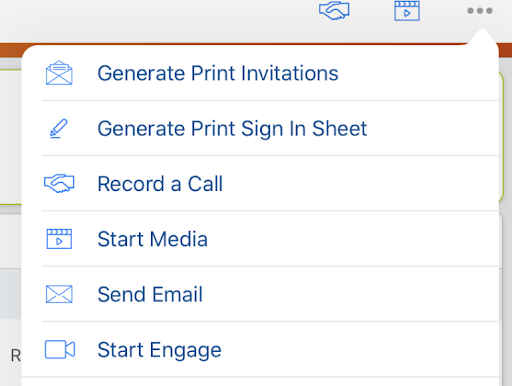
During the virtual event, hosts can perform the following actions:
- Mute/Unmute their own audio – If the host is not connected to the audio, the Join Audio button displays. Hosts can select this button to choose how to join the virtual event audio.
- Start/Stop their video
- Share Content – The types of content that can be shared varies based on the platform:
- iPad
- Screen
- Bookmark
- Photos
- Browser
- Desktop
-
Security – This button only displays when the event is hosted on the Browser platform and enables the following actions:
The options are available on the iPad by selecting the More menu.
- Lock Meeting – Disables additional attendees from joining the event
- Enable Waiting Room – See the Waiting Room section for more information
- Allow attendees to share their screen
- Allow Chat
- Allow attendees to rename themselves.
- Participants – Displays the video and audio status of each attendee. Additionally, if the attendee selected the Raise Hand button, a raised hand icon displays next to their name. From this list, hosts can perform the following actions:
- Mute/Unmute an attendee
- Remove from event
- Ask to Start Video/Stop Video
- Chat – Does not display if chat is disabled
- Mute/Unmute all attendees
- End Meeting – Displays the message "Do you want to end the meeting for all participants?"
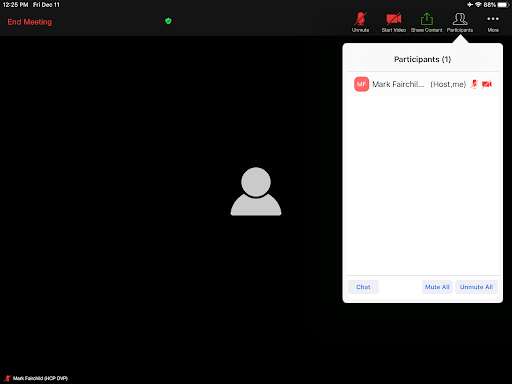
Using the Waiting Room
The Waiting Room is a feature that enables the host to prevent attendees or speakers from entering a meeting before the organizer is ready.
When an attendee or speaker enters the event, a message displays to the host.
To let attendees into the meeting:
- Select the Participants button.
- Select the appropriate attendee.
- Select Admit.
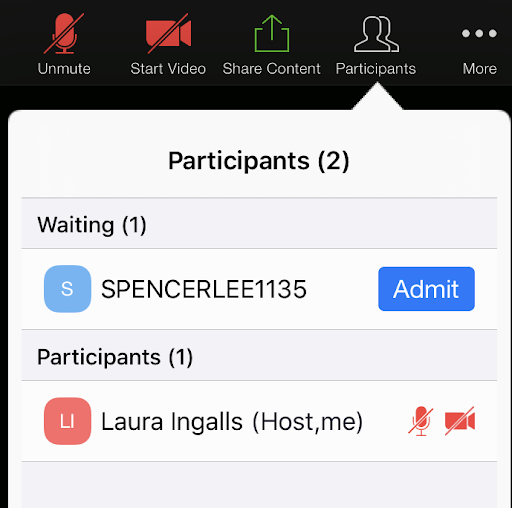
Optionally, the host can select Admit All to admit all waiting attendees.
The Waiting Room is automatically enabled for all meetings. Event organizers can disable the waiting room by selecting Security, then deselecting Enable Waiting Room.
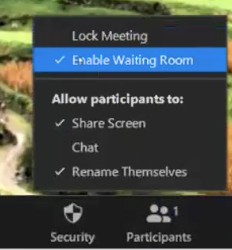
On the iPad platform, Enable Waiting Room is in the More menu of the Meeting Controls Menu.
Using Virtual Events as a Speaker
Speakers who receive an Approved Email with the meeting link can join a scheduled virtual event.
Speakers using Windows desktop devices can join the event either by downloading the Engage Speaker app, or by selecting a link at the bottom of the Join page to join the event via the Engage Web Client on any supported browser.

Speakers using Mac desktop devices automatically join the event via the Engage Web Client.
Sharing Screens During a Virtual Event
To share an application window or desktop during a virtual event:
- Select Share.
-
Select the appropriate application window or desktop. The following content is supported for screen sharing:
- Screen
- Open application windows
- Whiteboard
- Connected mobile device
Recording a Virtual Event
- iPad
- Browser (Classic)
Event organizers can record virtual events for future training, marketing, or auditing purposes. Recordings are stored in Veeva Vault and are available after the meeting.
For example, Sarah Jones hosts a virtual event on the efficacy of Cholecap. She selects the Record to the Cloud button as the event begins. Part way through the event, she selects the Cloud button and pauses the recording for a break. Sarah selects Record again when the event continues. After the event is complete, both recordings are stored together in Vault.
Recording a Virtual Meeting
Event organizers can begin recording by selecting the Record to the Cloud button in the More Actions menu.
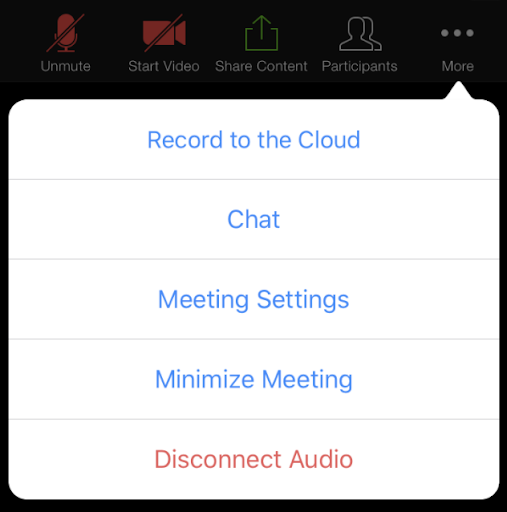
Organizers can pause or end the recording by selecting the Cloud button, then selecting the appropriate action. If a host stops or pauses a recording and then restarts, two recordings are saved.
After the host ends the event, all recordings made are uploaded to the configured Vault and are stored in a new Vault Binder. The created binder is named after the name and date of the event. The location of the created binder stamps in CRM on the Vault_Binder_Path_vod field on the EM_Event_vod record.
Reporting on Event Business Rules
- Browser (Classic)
Admins can create and run reports from event history records to better understand how event business rules are being used, for example, a report that tells you how frequently a specific account is violating an expense limit rule. Admins can analyze details about event business rules and violations caused by the rule to determine if a rule is functioning correctly. If a rule is not functioning correctly, the admin can use the information in the EM_Event_History_vod object to update the rule accordingly.
For example, Cathy Johnson, an admin, wants to monitor which accounts frequently violate a newly configured Per Attendee Attendance Rule, which limits the number of events an attendee can be invited to. She creates a report based on event history records created by the new rule. She notices that Clinton Ackerman’s account frequently violates the rule and determines the violations are incorrect. Based on this information, Cathy updates the Attendance Rule, allowing Dr. Ackerman to be invited to more events without violations.
Viewing a History of Event Business Rules
Whenever an Event Business Rule triggers a hard or soft warning, an EM_Event_History_vod record is created with a record type of EM_Business_Rule_History_vod and with the following fields:
|
Field |
Description |
|---|---|
|
Action_Type_vod |
Defaults to EM Business Rule Execution |
|
Event_vod |
References the corresponding event |
|
Action_Datetime_vod |
The date and time when the rule ran |
|
EM_Business_Rule_vod |
Stamps with the EM_Business_Rule_Id_vod field of the corresponding event business rule |
|
EM_Business_Rule_Configuration_vod |
Stamps with the EM_Business_Rule_Id_vod field of the corresponding event business rule |
|
EM_Business_Rule_Type_vod |
The record type of the corresponding event business rule |
|
User_vod |
References the user that initiated the Rule |
|
Run_Rule_Type_vod |
References the Run Rule Type of the corresponding event business rule |
|
Event_Action_vod |
References the Run_Rule_Event_Action_vod field of the corresponding event business rule |
|
Warning_Type_vod |
References the Warning_Type_vod field of the corresponding event business rule |
|
Record_Violated_ID_vod |
SFID of the record that violated the rule. Depending on the record type, this can be either an EM_Event_vod record or an EM_Attendee_vod record. |
|
Record_Violated_Name_vod |
Stamps with the name of the record that caused the violation |
|
EM_Attendee_Account_vod |
Populates if the record that violated the rule is an EM_Attendee_vod record for an Account |
|
EM_Attendee_User_vod |
Populates if the record that violated the rule is an EM_Attendee_vod record for a User |
|
EM_Attendee_Contact_vod |
Populates if the record that violated the rule is an EM_Attendee_vod record for a Contact |
|
Platform_vod |
The platform where the rule was run |


